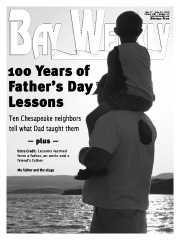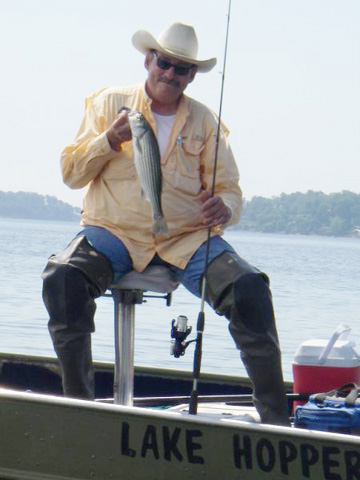Chesapeake Bay's Independent Newspaper ~ Since 1993
1629 Forest Drive, Annapolis, MD 21403 ~ 410-626-9888
Volume xviii, Issue 24 ~ June 17 to June 23, 2010
Home \\ Correspondence \\ from the Editor \\ Submit a Letter \\ Classifieds \\ Contact Us
Best of the Bay \\ Dining Guide \\ Home & Garden Guide \\ Archives \\ Distribution \\ Advertising![]()


Perch in a Poke
An old salt teaches this old dog a new lesson
It felt like a good fish right from the start. Lifting my rod tip at the strike, I felt solid resistance, then a headshake. Then the perch shot out from deep under the dock where I had hooked it. On its way out, the crafty devil also cornered at the nearest barnacle-encrusted piling and cut the line.
I shook my head and reached for another spinner bait. This wasn’t the first big white perch to have done me dirt that morning. A number of whities finning in our five-gallon bucket were easily over 10 inches, but at least four or five larger perch had already burned us in one fashion or another. These big dock-lurkers were obviously battle tested and savvy in giving even seasoned anglers the slip.
Losing a few fish doesn’t bother me. It just makes me more determined. Besides, I had already realized that I was rigged too light for fishing under these piers. Six-pound mono on a long, light-action spin rod was giving way too much edge to the stocky brawlers lurking inside the forests of barnacled line shredders.
The Dockmaster
|
|
![]() We were fishing the numerous boat docks and piers on the Severn in a way I had never done before, courtesy of an old salt named Woody Tillery. Woody was showing my son, Harrison, and me how to score on jumbo white perch around the shoreline structures, even in what I considered adverse conditions: low water and bright sunshine.
We were fishing the numerous boat docks and piers on the Severn in a way I had never done before, courtesy of an old salt named Woody Tillery. Woody was showing my son, Harrison, and me how to score on jumbo white perch around the shoreline structures, even in what I considered adverse conditions: low water and bright sunshine.
Woody had gassed up, baited up, rigged up and was ready to go when we arrived at sunup with our skiff at the Severn River ramp. Another friend, Ed Robinson, was also fishing with Woody.
We began the morning with high water, fishing for whities in the more traditional manner, targeting laydowns and submerged brush along long, shaded shorelines. We encountered some good action but not many perch the size we were after. Woody had promised jumbos and insisted we weren’t going to keep anything smaller than 10 inches.
At mid-morning with the sun climbing up in the sky and our tide fading, I began to suspect that we might not get it done that day. Woody, however, was undismayed. “Looks like it’s not going to happen here,” he announced. “We’ll have to start working the docks and piers for the fish we want. They’ll be concentrated there in the shade by now and won’t be so scattered. We’ll get ’em.”
I had fished around those structures before for perch but not quite, I soon discovered, in the style Woody had in mind. He used his handcrafted one-eighth-ounce, safety pin-style, feathered spinner baits in white and chartreuse. Methodically, he worked the shaded areas of each of the piers all the way back to the shoreline.
Casting his baits far under the structures, he let them sink to the bottom before cranking them smartly back. With a six-and-a-half-foot, medium-action spin rod and 15-pound mono, when he got a strike, he would quickly lead the fish from under its refuge to do battle out in the open.
“My best fish from under these piers was a 40-pound-class striper one fall a few years ago,” he explained later as we discussed gear. “Twenty-pound braid or 15-pound mono, certainly nothing lighter than 10-pound, might seem heavy for perch. But with these pilings, barnacles and the occasional big rockfish, it’s really ultra-light tackle when you think about it.”
That seemed sound logic to me.
Woody and Ed were still hammering casts around and under the Severn’s many docks and piers when Harrison and I had to depart at about noon. Their live well was populated with fish over our self-imposed minimum size, and almost all of them were from under the docks.
Neither my son nor I brought home perch in the 12-and-over category, but I bet we had each lost at least one or two of that size. We did manage enough fish over 10 inches for a family dinner for five the next night. The extra-thick fillets were delicious.
Just before we pulled out that day, we watched Woody finesse a 191⁄2-inch rockfish from under a structure, a nice touch for a fish-wise and generous guy my son and I had nicknamed The Dockmaster.
You might get some tips from The Dockmaster or even some of his handcrafted spinnerbaits at the Pasadena Sportfishing Group Meeting the second Monday of every month at the Earleigh Heights Fire Hall. Or call him at 443-962-3731.
Fish Are Biting
Spot are arriving in good numbers now, and live-lining is the popular method for catching nice rockfish on light tackle. Trollers also get good catches of stripers, dragging smaller bucktails and soft plastic swim shad. Bluefish are gradually growing in numbers but not in size. The schools of hardhead (aka croaker) are well distributed now, though most of these strong, fighting pan fish remain in the middle zone of 10 to 14 inches. White perch are gathering well over hard bottoms in 15 to 30 feet. Only Spanish mackerel have yet to make an appearance.
The influx of cow-nose rays is also well underway, and they are even more numerous this year than last. They promise to be quite a nuisance. More and more people are finding them good eating if prepared properly, and they can certainly provide quite a battle when hooked. Care should be taken, however, when landing them. They have a barb near the base of their tail that can inflict an extremely painful (but not fatal) wound.
Crabbing continues to improve in June from merely really good to excellent. Most crabs are legal sized, fat and still growing. A banner year is well underway on the Chesapeake.
© COPYRIGHT 2010 by New Bay Enterprises, Inc. All rights reserved.

